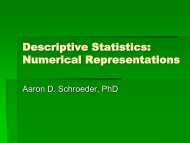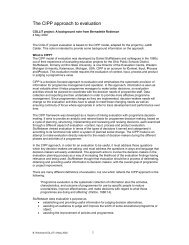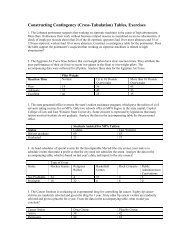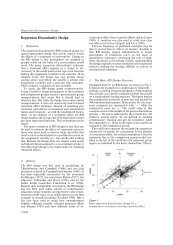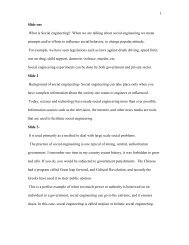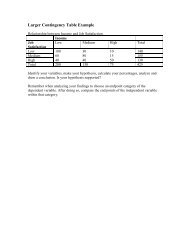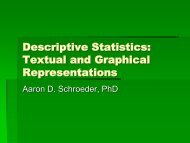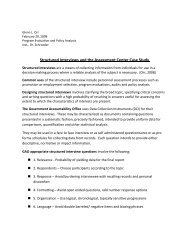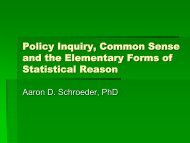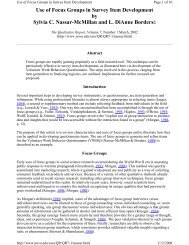Analysis of Nominal and Ordinal Data (pdf)
Analysis of Nominal and Ordinal Data (pdf)
Analysis of Nominal and Ordinal Data (pdf)
Create successful ePaper yourself
Turn your PDF publications into a flip-book with our unique Google optimized e-Paper software.
<strong>Analysis</strong> <strong>of</strong> <strong>Nominal</strong><br />
<strong>and</strong> <strong>Ordinal</strong> <strong>Data</strong><br />
•Construction <strong>and</strong> <strong>Analysis</strong> <strong>of</strong><br />
Contingency Tables<br />
•Statistical Aids for Interpretation<br />
•Control Table <strong>Analysis</strong><br />
•Aaron D. Schroeder, PhD
Construction <strong>and</strong> <strong>Analysis</strong><br />
<strong>of</strong> Contingency Tables<br />
• We have previously discussed levels <strong>of</strong><br />
measurement (nominal, ordinal, interval),<br />
<strong>and</strong> the measures <strong>of</strong> central tendency<br />
<strong>and</strong> dispersion that can be used to<br />
summarize a group <strong>of</strong> data – This was<br />
single variable or “univariate” statistics<br />
• This type <strong>of</strong> analysis is common, but<br />
generally reflects the first step in the<br />
analysis <strong>of</strong> a problem
• Imagine you work in the Public Affairs<br />
department <strong>of</strong> a large state agency<br />
• Just finished annual survey <strong>of</strong> public opinion<br />
toward the agency<br />
• Initial results show most people feel agency is<br />
doing a “very poor job” with a median <strong>of</strong> “poor<br />
job”<br />
• This is a dramatic downturn from previous<br />
years<br />
• Now that you have done the descriptive,<br />
univariate statistics, what do you do?
• You DON‟T want to give this information to the agency<br />
director without some idea <strong>of</strong> how the public image <strong>of</strong><br />
the agency might be improved<br />
• You need to consider WHY public support has fallen<br />
• Perhaps program cuts hit a particularly populous<br />
county harder than others<br />
• Perhaps the new director has a bad reputation “Mean”<br />
Gean Maculroy they call him<br />
• Either explanation would result in completely different<br />
approaches to improving the public image <strong>of</strong> the<br />
agency<br />
• In both, we want to know the “relationship” between<br />
TWO variables (county <strong>and</strong> opinion, view <strong>of</strong> director<br />
<strong>and</strong> opinion)
• The method that is most employed to<br />
quickly analyze the relationship between<br />
two variables is called Contingency Table<br />
<strong>Analysis</strong> or the analysis <strong>of</strong> Crosstabulations<br />
(Cross-tabs)<br />
• Here we will learn hw to construct crosstabs<br />
<strong>and</strong> interrupter them
Percentage Distributions<br />
• First, though, we will review percentage<br />
distributions, as they are integral to crosstabulations<br />
• As we have explored before, a percentage<br />
distribution is simply a frequency distribution<br />
that has been converted to percentages<br />
• It tabulates the percentage associated with<br />
each data value or group (class) <strong>of</strong> data values
Percentage Distributions<br />
• Consider this table <strong>of</strong><br />
responses to whether or<br />
not there are “too many”<br />
bureaucrats in the<br />
federal government<br />
• Mode is “Agree”, but still<br />
difficult to interpret<br />
• Percentages would<br />
make it easier to<br />
interpret <strong>and</strong> compare to<br />
previous years<br />
Response<br />
Strongly Agree 686<br />
Agree 979<br />
Neutral 208<br />
Disagree 436<br />
Strongly<br />
Disagree<br />
Number <strong>of</strong><br />
People<br />
232<br />
2,541
Steps in Percentaging<br />
• The steps for Percentaging are easy:<br />
• 1. Add the number <strong>of</strong> people (frequencies)<br />
giving each <strong>of</strong> the responses. In our table that‟s<br />
686+979+208+436+232=2,541<br />
• 2. Divide each <strong>of</strong> the individual frequencies by<br />
this total <strong>and</strong> multiply the result by 100. For<br />
“Strongly Agree” we divide 686 by 2,541, then<br />
multiply by 100 = 26.997<br />
• So, about 27.0 percent responded “Strongly<br />
Agree”
Displaying <strong>and</strong> Interpreting<br />
Percentage Distributions<br />
• It is clear from this<br />
distribution that most<br />
respondents “Agree”<br />
with the statement<br />
<strong>and</strong> that the extent <strong>of</strong><br />
“general agreement”<br />
far outweighs the<br />
extent <strong>of</strong> “general<br />
disagreement”<br />
Response<br />
Strongly Agree 27.0<br />
Agree 38.5<br />
Neutral 8.2<br />
Disagree 17.2<br />
Strongly<br />
Disagree<br />
Percentage<br />
9.1<br />
Total 100.0<br />
N = 2,541
Collapsing Percentage<br />
Distributions<br />
Response<br />
Strongly Agree or Agree 65.5<br />
Neutral 8.2<br />
Disagree or Strongly Disagree 26.3<br />
Total 100.0<br />
Percentage<br />
N = 2,541<br />
• It is perfectly ok to collapse percentage distributions as long as the<br />
categories are close in substantive meaning (e.g. you can‟t include<br />
Neutral with either collapsed category<br />
• The only time you can violate that rule is when dealing with nominal<br />
variables where there are many categories with little data (e.g.<br />
Protestant 62%, Catholic 22%, Jewish 13%, Other 3%)
In-Class Task<br />
• Construct a<br />
collapsed<br />
percentage<br />
distribution <strong>of</strong><br />
the data here<br />
• How would<br />
you collapse<br />
it?<br />
• One will<br />
present<br />
Where do people shop?<br />
Main Store Named (<strong>and</strong> location)<br />
Cleo‟s (neighborhood store) 5<br />
Morgan‟s (downtown) 18<br />
Wiese‟s (eastern shopping center) 12<br />
Cheatham‟s (neighborhood store) 2<br />
Shop City (eastern shopping center) 19<br />
Food-o-Rama (western shopping center) 15<br />
Stermer‟s (downtown) 7<br />
Binzer‟s (neighborhood store) 2<br />
Engl<strong>and</strong>‟s (western shopping center) 1<br />
Bargainville‟s (eastern shopping center) 26<br />
Whiskey River (downtown) 13<br />
Number <strong>of</strong><br />
Persons<br />
120
Contingency Table<br />
<strong>Analysis</strong><br />
• A “univariate” frequency distribution<br />
simply presents the number <strong>of</strong> cases (or<br />
frequency) taking each value <strong>of</strong> a given<br />
variable<br />
• A “bivariate” frequency distribution<br />
presents the number <strong>of</strong> cases that fall<br />
into each possible pairing <strong>of</strong> the values or<br />
categories <strong>of</strong> two variables<br />
simultaneously
Constructing Contingency<br />
Tables<br />
• Consider the<br />
variables “race” <strong>and</strong><br />
“gender” for<br />
volunteers to the<br />
Klondike<br />
Expessionist Art<br />
Museum<br />
• There are four<br />
possible pairings<br />
“Gender”<br />
Female<br />
Male<br />
“Race”<br />
White<br />
Nonwhite
Constructing Contingency<br />
Tables<br />
• The cross-tabulation <strong>of</strong><br />
these two variables<br />
displays the number <strong>of</strong><br />
cases (volunteers) that<br />
fall into each <strong>of</strong> the racegender<br />
combinations<br />
• Called a “crosstabulation”<br />
precisely<br />
because it it crosses<br />
(<strong>and</strong> tabulates) each <strong>of</strong><br />
the categories <strong>of</strong> one<br />
variable with each <strong>of</strong> the<br />
categories <strong>of</strong> a second<br />
variable<br />
Race <strong>and</strong> Gender <strong>of</strong> Volunteers to<br />
Klondike Expressionist Art Museum<br />
Race<br />
Sex White Nonwhite Total<br />
Male 142 109 251<br />
Female 67 133 200<br />
Total 209 242 451
Terminology<br />
• Cell<br />
• The cross-classification <strong>of</strong><br />
one category each from<br />
two variables<br />
• Marginals<br />
• The totals <strong>of</strong> each column<br />
<strong>and</strong> the totals for each row<br />
• Gr<strong>and</strong> Total<br />
• The total number <strong>of</strong> cases<br />
represented in the table<br />
(N)<br />
Race <strong>and</strong> Gender <strong>of</strong> Volunteers to<br />
Klondike Expressionist Art Museum<br />
Race<br />
Sex White Nonwhite Total<br />
Male 142 109 251<br />
Female 67 133 200<br />
Total 209 242 451
In-Class Task<br />
• Create a cross-tabulation called “Relationship<br />
between Type <strong>of</strong> Employment <strong>and</strong> Attitude<br />
toward Balancing the Federal Budget”<br />
• The variables <strong>of</strong> interest are “type <strong>of</strong><br />
employment” (public, private, nonpr<strong>of</strong>it) <strong>and</strong><br />
“attitude toward balancing the federal budget”<br />
(approve, disapprove)<br />
• The cell frequencies are: public-disapprove 126;<br />
public-approve 54; private-disapprove 51;<br />
private-approve 97; nonpr<strong>of</strong>it-disapprove 25;<br />
nonpr<strong>of</strong>it-approve 38
Relationships Between<br />
Variables<br />
• Managers make <strong>and</strong> analyze cross-tabs<br />
because they are interested in the relationship<br />
between two variables<br />
• A statistical relationship is a recognizable<br />
change in one variable as the other variable<br />
changes<br />
• The cell frequencies <strong>of</strong> a cross-tabulation<br />
provide some information regarding whether<br />
changes in one variable are statistically related<br />
to changes in another
Relationships Between<br />
Variables<br />
Relationship between Educational Level <strong>and</strong><br />
Performance on Civil Service Examination<br />
Performance<br />
on Civil Service<br />
Examination<br />
High School or<br />
Less<br />
Education<br />
More Than High<br />
School<br />
Total<br />
Low 100 200 300<br />
High 150 800 950<br />
Total 250 1,000 1,250
<strong>Analysis</strong> Process<br />
• Step 1 – Determine which variable is<br />
Independent <strong>and</strong> which is Dependent<br />
• Independent variable – the anticipated<br />
causal variable – the one that leads to<br />
changes or effects in the other variable<br />
• Dependent variable – the one that gets<br />
influenced
<strong>Analysis</strong> Process<br />
• Stated as a Hypothesis: the higher the<br />
education, the higher the expected score<br />
on the test<br />
• So, education is the independent variable<br />
<strong>and</strong> performance on the test is the<br />
dependent variable
<strong>Analysis</strong> Process<br />
• Step 2 – Calculate percentages within the<br />
categories <strong>of</strong> the independent variable<br />
• In this case, education<br />
• We would like to know the percentage <strong>of</strong><br />
people with high school education or less (low<br />
education) who received high scores on the<br />
exam <strong>and</strong> the percentage <strong>of</strong> people with more<br />
than a high school education (high education)<br />
who received high scores<br />
• We could then compare <strong>and</strong> test our<br />
hypothesis
• Go ahead <strong>and</strong> calculate the percentages within the<br />
categories <strong>of</strong> the independent variable<br />
Relationship between Educational Level <strong>and</strong> Performance<br />
on Civil Service Examination<br />
Performance<br />
on Civil<br />
Service<br />
Examination<br />
High School or<br />
Less<br />
Education<br />
More Than<br />
High School<br />
Total<br />
Low 100 200 300<br />
High 150 800 950<br />
Total 250 1,000 1,250
<strong>Analysis</strong> Process<br />
• Step 3 – Compare the percentages calculated<br />
within the categories <strong>of</strong> the independent<br />
variable for one <strong>of</strong> the categories <strong>of</strong> the<br />
dependent variable<br />
• For example, whereas 80% <strong>of</strong> those with high<br />
education earned high scores on the civil<br />
service examination, only 60% <strong>of</strong> those with<br />
low education did so.<br />
• Therefore, our hypothesis is supported by<br />
these data
<strong>Analysis</strong> Process<br />
• Step 4 (optional) – Calculate a percentage<br />
difference across one <strong>of</strong> the categories <strong>of</strong> the<br />
dependent variable<br />
• Not usually included in the table, but in the<br />
write-up discussing support for the hypothesis<br />
• A percentage difference is a measure<br />
<strong>of</strong> the strength <strong>of</strong> the relationship<br />
between the two variables
In-Class Task<br />
• Automobile Maintenance in Berrysville<br />
h<strong>and</strong>out
Larger Contingency<br />
Tables<br />
• In cross-tabs larger than 2 x 2 analysis is<br />
conducted using the same process<br />
• However, the choice <strong>of</strong> which category <strong>of</strong><br />
the Dependent Variable is selected for<br />
analysis requires more care (it doesn‟t<br />
matter in a 2x2 table)<br />
• Avoid intermediate categories – choose an<br />
endpoint category – choose “low” or “high”<br />
in a “low”, “medium”, “high” variable<br />
• Do the same for the Independent Variable
In-Class Task<br />
• Relationship between Income <strong>and</strong> Job<br />
Satisfaction h<strong>and</strong>out
Hypothesis 1: The higher the income, the higher the job satisfaction<br />
Hypothesis 2 (corollary): The lower the income, the lower the job satisfaction
Which one should you use?<br />
• Since they both confirm your hypothesis, but to<br />
a different degree, report BOTH.<br />
• Income appears to make a difference <strong>of</strong> 37%<br />
to 47% in job satisfaction.<br />
• What if the two disagree?<br />
• Then you really can‟t draw a conclusion. The<br />
problem is more complex than you thought <strong>and</strong><br />
you‟ll have to revisit what you thought the<br />
relationship was <strong>and</strong> how you have phrased<br />
the question.
Displaying Contingency<br />
Tables<br />
• Conventions for the display <strong>of</strong> contingency tables or<br />
cross-tabs<br />
• Don‟t show the raw frequencies – just show the percentages<br />
• The independent variable is placed along the columns <strong>of</strong> the<br />
table<br />
• The dependent variable is positioned down the rows <strong>of</strong> the<br />
table<br />
• The independent variable (if ordinal) should progress from left<br />
to right (least to most)<br />
• The dependent variable (if ordinal) should progress from top to<br />
bottom (least to most)<br />
• The percentages calculated within the categories <strong>of</strong> the<br />
independent variable are summed down the column with a<br />
total at the foot <strong>of</strong> the respective column<br />
• The total number <strong>of</strong> cases (n=) is listed below the total<br />
percentage for each column
Conventional Format for a<br />
Contingency Table<br />
Dependent<br />
Variable<br />
Substantive<br />
meaning <strong>of</strong><br />
categories<br />
increases<br />
Independent Variable<br />
Substantive meaning <strong>of</strong> categories increases (e.g., “low,” “medium,” “high”)<br />
_____% _____% _____% _____%<br />
_____% _____% _____% _____%<br />
_____% _____% _____% _____%<br />
Total 100.0% 100.0% 100.0% 100.0%<br />
(n = ___ ) (n = ___ ) (n = ___ ) (n = ___ )
Computer Printouts<br />
• Be careful with computer contingency tables<br />
(like excel)<br />
• The “wizards” can give three different<br />
percentages<br />
• Columns<br />
• Rows<br />
• Percentage <strong>of</strong> Total Table<br />
• It doesn‟t know any better – you need to know<br />
better!
In-Class Problems<br />
• Teams <strong>of</strong> 2<br />
• Prepare <strong>and</strong> present
Question 1<br />
• The Lebanon postmaster suspects that working on<br />
ziptronic machines is the cause <strong>of</strong> high absenteeism.<br />
More than 10 absences from work without businessrelated<br />
reasons is considered excessive absenteeism.<br />
A check <strong>of</strong> employee records shows that 26 <strong>of</strong> the 44<br />
ziptronic operators had 10 or more absences <strong>and</strong> 35 <strong>of</strong><br />
120 non-ziptronic workers had 10 or more absences.<br />
Construct a contingency table for the postmaster. Does<br />
the table support the postmaster‟s suspicion that<br />
working on ziptronic machines is related to high<br />
absenteeism?
Question 2<br />
The Egyptian Air Force brass believe that overweight pilots have slow<br />
reaction times. They attribute the poor performance <strong>of</strong> their air force in<br />
recent war games in the Sinai to overweight pilots. The accompanying<br />
data were collected for all pilots. Analyze these data for the Egyptian Air<br />
Force.<br />
Pilot Weight<br />
Reaction<br />
Time<br />
Normal Up to 10<br />
Pounds<br />
Overweight<br />
Poor 14 36 45<br />
Adequate 35 40 33<br />
Excellent 46 25 15<br />
More than<br />
10 Pounds<br />
Overweight
Question 3<br />
The state personnel <strong>of</strong>fice oversees the state‟s tuition assistance program,<br />
which pays the tuition <strong>of</strong> civil servants taking courses for an MPA. Only two<br />
schools <strong>of</strong>fer an MPA degree in the state capital, Capital College <strong>of</strong> Law <strong>and</strong><br />
East Winslow State University. Some concern is expressed by legislators that<br />
many tuition-assisted students do not graduate. Analyze the data in the<br />
accompanying table for the personnel <strong>of</strong>fice.<br />
Students Assisted for MPA Tuition<br />
Status Capital East Winslow<br />
Did not graduate 69 83<br />
Graduated 23 37
Question 4<br />
As head scheduler <strong>of</strong> special events for the Incomparable<br />
Myriad (the city arena), your task is to schedule events<br />
that make a pr<strong>of</strong>it so that the city need not subsidize the<br />
arena. Analyze the data in the accompanying table, which<br />
is based on last year‟s data, <strong>and</strong> report to the city council.<br />
Type <strong>of</strong> Event<br />
Status Hockey Games Religious<br />
Rallies<br />
Not<br />
Pr<strong>of</strong>itable<br />
Basketball<br />
Games<br />
Rock Concerts<br />
24 4 21 2 3<br />
Pr<strong>of</strong>itable 18 32 6 8 0<br />
Public<br />
Administration<br />
Conventions
Question 5<br />
The Cancer Institute is evaluating an experimental drug for<br />
controlling lip cancer. Eighty lip cancer victims are<br />
r<strong>and</strong>omly selected <strong>and</strong> given the drug for 1 year. Sixty<br />
other lip cancer victims are r<strong>and</strong>omly selected <strong>and</strong> given a<br />
placebo for a year. From the data in the accompanying<br />
table, what would you conclude?<br />
Cancer Status Drug Group Placebo Group<br />
Active 58 42<br />
Remission 22 18
Question 6<br />
A pr<strong>of</strong>essor <strong>of</strong> public administration has kept records on the class<br />
participation <strong>of</strong> his students over the past several years. He has a<br />
strong feeling (hypothesis) that class participation is related to grade in<br />
the course. For this analysis he classifies course grades into two<br />
categories, fail <strong>and</strong> pass. He operationalizes class participation as “low”<br />
if the student participated in class discussion in fewer than 25% <strong>of</strong> class<br />
periods, <strong>and</strong> “high” if the student participated in 25% or more <strong>of</strong> the<br />
periods. Based on these definitions, he has assembled the crosstabulation<br />
below. Does a relationship exist between class participation<br />
<strong>and</strong> course grades?<br />
Class Participation<br />
Grade in Course Low High<br />
Fail 56 15<br />
Pass 178 107
Question 7<br />
Madonna Lewis‟s job in the Department <strong>of</strong> Sanitary Engineering is to<br />
determine whether new refuse collection procedures have improved<br />
the public‟s perception <strong>of</strong> the department. Public opinion surveys<br />
were taken both before <strong>and</strong> after the new procedures were<br />
implemented. The results appear in the accompanying table.<br />
Analyze the table, <strong>and</strong> evaluate whether public perception <strong>of</strong> the<br />
department appears to have improved over time.<br />
Opinion Before After<br />
Department is<br />
doing a poor job<br />
Department is<br />
doing a good<br />
job<br />
79 73<br />
23 47
BREAK
Statistical Aids for<br />
Interpretation<br />
• So we now know how to determine if two<br />
nominal or ordinal variables are related<br />
statistically using a contingency table <strong>and</strong><br />
percentages<br />
• But now we have to ask, “How strong” is that<br />
relationship?<br />
• Can we say that the relationship is “strong<br />
enough” to have not occurred by chance?
Chi-Square Test: Statistical<br />
Significance for Contingency Tables<br />
• A procedure for evaluating the level <strong>of</strong> statistical<br />
significance attained by a bivariate relationship in a<br />
cross-tabulation<br />
• Statistical Significance – how confident can we be that<br />
this sample <strong>of</strong> data represents its parent population?<br />
(We will get into this in more detail next week, but this<br />
definition is sufficient for now)<br />
• Chi Square – assumes there is “no relationship”<br />
between the two variables <strong>and</strong> determines if the<br />
relationship you think you are seeing is possibly just do<br />
to chance
Chi Square – 3 Steps<br />
• First – you calculate “expected frequencies” for<br />
each cell in your contingency table – what<br />
would be there if the was “no” relationship<br />
• Second – you calculate the difference between<br />
these expected frequencies <strong>and</strong> the actual<br />
frequencies – this is Chi Square<br />
• Third – you look up the value in a table to<br />
determine the degree <strong>of</strong> confidence that a<br />
relationship exists
Chi-Square Example – Step<br />
By Step<br />
• A disgruntled <strong>of</strong>ficial working in the personnel<br />
department <strong>of</strong> a large federal bureaucracy is<br />
disturbed by the level <strong>of</strong> incompetence she<br />
perceives in the leadership <strong>of</strong> the organization.<br />
• She is convinced that incompetence rises to<br />
the top<br />
• She shares this thought with a coworker who<br />
challenges her to substantiate her claim
Chi-Square Example – Step<br />
By Step<br />
• So, ignoring all personnel law, she selects a<br />
r<strong>and</strong>om sample <strong>of</strong> 400 people employed by the<br />
organization<br />
• Using their civil service exams, she classifies<br />
them into three levels <strong>of</strong> competence (low,<br />
medium, high)<br />
• Using their job descriptions, she classifies<br />
them into three levels <strong>of</strong> hierarchical position<br />
(low, medium, high)
Chi-Square Example – Step<br />
By Step<br />
Cross-Tabulation <strong>of</strong> Competence <strong>and</strong> Hierarchy<br />
Competence<br />
Hierarchy Low Medium High Total<br />
Low 113 60 27 200<br />
Medium 31 91 38 160<br />
High 8 8 24 40<br />
Total 152 159 89 400
Chi-Square : Step 1<br />
• Compute the expected frequencies for each<br />
cell assuming no relationship between the<br />
independent <strong>and</strong> dependent variables (need to<br />
be working with actual frequencies, not<br />
percentages)<br />
• For no relationship, we would expect there to<br />
be identical distributions <strong>of</strong> the dependent<br />
variable for each value <strong>of</strong> the independent<br />
variable<br />
• For each level <strong>of</strong> “Competence” (low, medium,<br />
high), the distribution o hierarchy (low,<br />
medium, high) should be the same
No Relationship would<br />
look like this<br />
Hypothetical No-Relationship Cross-Tabulation for Chi-Square<br />
Competence<br />
Hierarchy Low Medium High Total<br />
Low 50% 50% 50% 50%<br />
(n=200)<br />
Medium 40% 40% 40% 40%<br />
(n=160)<br />
High 10% 10% 10% 10% (n=40)<br />
The proportion for each value <strong>of</strong> the Hierarchy would be the same for each<br />
Level <strong>of</strong> Competence (e.g. if the total proportion <strong>of</strong> “low in the hierarchy”<br />
Is 50%, then it would be 50% for each value <strong>of</strong> competence
Chi-Square : Step 1<br />
• Calculating the expected<br />
frequencies is<br />
cumbersome but easy<br />
• Multiply the total<br />
proportional percentage<br />
<strong>of</strong> a value <strong>of</strong> the<br />
dependent variable (e.g.<br />
low in the hierarchy is<br />
50%) by the total for<br />
each value <strong>of</strong> the<br />
independent variable<br />
(e.g. 152 for low<br />
competence)<br />
Cross-Tabulation <strong>of</strong> Competence <strong>and</strong><br />
Hierarchy<br />
Competence<br />
Hierarchy Low Med High Total<br />
Low .50 x 152 =<br />
76.0<br />
200<br />
(50%)<br />
Medium 160<br />
(40%)<br />
High 40<br />
(10%)<br />
Total 152 159 189 400<br />
(100%)
Chi-Square : Step 1<br />
Calculations for Expected Frequencies<br />
Table Cell<br />
Competence Hierarchy Observed Expected<br />
Low Low 113 .50x152=76.0<br />
Low Medium 31 .40x152=60.8<br />
Low High 8 .10x152=15.2<br />
Medium Low 60 .50x159=79.5<br />
Medium Medium 91 .40x159=63.6<br />
Medium High 8 .10x159=15.9<br />
High Low 27 .50x89=44.5<br />
High Medium 38 .40x89=35.6<br />
High High 24 .10x89=8.9<br />
Total 400 400
Chi-Square : Step 2<br />
• Compute the value <strong>of</strong> Chi-Square<br />
• Find out what the difference is between<br />
each observed frequency <strong>and</strong> what<br />
would be expected if no relationship<br />
• Square that difference<br />
• Divide that by the expected frequency<br />
• Add them all up, <strong>and</strong>, voila, you‟ve got<br />
chi-square!
Chi-Square : Step 2<br />
Calculations for Expected Frequencies<br />
Table Cell<br />
Competence Hierarchy Observed Expected (O-E) 2 /E<br />
Low Low 113 .50x152=76.0 18.01<br />
Low Medium 31 .40x152=60.8 14.61<br />
Low High 8 .10x152=15.2 3.41<br />
Medium Low 60 .50x159=79.5 4.78<br />
Medium Medium 91 .40x159=63.6 11.8<br />
Medium High 8 .10x159=15.9 3.93<br />
High Low 27 .50x89=44.5 6.88<br />
High Medium 38 .40x89=35.6 .16<br />
High High 24 .10x89=8.9 25.62<br />
Total 400 400 89.2<br />
CHI-SQUARE!
Chi-Square : Step 3<br />
• Figure out the degrees <strong>of</strong> freedom <strong>and</strong><br />
statistical significance level<br />
• Degrees <strong>of</strong> freedom: How big is your table? Multiply<br />
number <strong>of</strong> rows -1 by number <strong>of</strong> columns – 1; so,<br />
(3-1)x(3-1)=4<br />
• Statistical significance level: probability your „wrong‟<br />
– chance you‟re willing to put up with<br />
(conventionally set at 5%)<br />
• Look it up!<br />
• Back <strong>of</strong> any stats or methods book, Chi-Square<br />
distribution table (4 df down the side, .05 across the<br />
top)
Chi-Square : Step 3<br />
• What value do you get?<br />
• If your chi-square value is higher than that,<br />
then you‟ve found a relationship that is<br />
statistically significant!<br />
• So, is there a relationship between<br />
Competence <strong>and</strong> Hierarchy?<br />
• Is her hypothesis correct?<br />
• In class – percentage the table <strong>and</strong> evaluate
Limitations <strong>of</strong> Chi-Square<br />
• Chi-square helps you determine if a<br />
relationship exists (is statistically<br />
significant)<br />
• Chi-square does not tell you how<br />
strong that relationship is or which<br />
direction that relationship takes<br />
(positive, negative, etc.)
Assessing the Strength <strong>of</strong> a<br />
Relationship: Percentage Difference<br />
• The easiest <strong>and</strong> most<br />
common method for<br />
assessing the strength<br />
<strong>and</strong> direction <strong>of</strong> a<br />
relationship is to simply<br />
use the percentage<br />
distribution!<br />
• Do this BEFORE trying<br />
any fancier statistics!<br />
• The closer you are to a<br />
perfect positive or<br />
negative relationship,<br />
the stronger the<br />
relationship!<br />
Perfect Positive Relationship<br />
Dependent<br />
Variable<br />
Independent Variable<br />
Category 1 Category 2<br />
Category 1 100% 0%<br />
Category 2 0% 100%<br />
100% 100%
In-Class Task<br />
• Figure chi-square for this<br />
table as well as<br />
percentaging it<br />
• Is there a statistically<br />
significant relationship<br />
there at the 5% level;<br />
what about the 10%<br />
level?<br />
• Looking at the<br />
percentages, can you<br />
state the relationship in<br />
“directional” language?<br />
Capital<br />
Punishment<br />
Percent in<br />
Favor<br />
Percent<br />
Opposed<br />
Liberal Conservative<br />
25 52<br />
37 43
Measures <strong>of</strong> Association<br />
• What if you can‟t really tell how strong the relationship<br />
is, or in what direction?<br />
• Like if you have a very large table?<br />
• That‟s when you use “measures <strong>of</strong> association” –<br />
fancier stats<br />
• Cramer‟s V, lambda, Gamma, Somer‟s d, <strong>and</strong> others<br />
• They give you a number that you can tell the strength<br />
<strong>and</strong> direction (if ordinal or interval) <strong>of</strong> a relationship<br />
• If stat made for <strong>Nominal</strong> data (e.g. Cramer‟s V), then<br />
the number will be between 0 <strong>and</strong> 1 (e.g. .49)<br />
• If made for ordinal/interval, then will usually be<br />
between -1 <strong>and</strong> 1 to give both strength <strong>and</strong> direction.
A Common Measure:<br />
Cramer’s V<br />
• While you will generally not run across<br />
many measures <strong>of</strong> association in your<br />
work, if you d, it will most likely be<br />
Cramer‟s V<br />
• Non-directional between 0-1
Statistical Control Table<br />
<strong>Analysis</strong><br />
• According to<br />
this percentage<br />
distribution,<br />
does Ice Cream<br />
Consumption<br />
influence the<br />
rate <strong>of</strong> juvenile<br />
crime?<br />
• What might be<br />
going on?<br />
Relationship between Juvenile Crime <strong>and</strong> Ice<br />
Cream Consumption<br />
Ice Cream Consumption<br />
Crime rate Low High<br />
Low 25% 80%<br />
High 75% 20%<br />
Total 100% 100%<br />
(n = 20<br />
precincts)<br />
(n = 25<br />
precincts)
Controlling for a Third<br />
Variable<br />
SES<br />
Ice Cream<br />
Consumption<br />
?<br />
Juvenile Crime
Controlling for a Third<br />
Variable<br />
• How we control for a third variable is<br />
deceptively simple<br />
• You just examine the relationship<br />
between the original two variables within<br />
each <strong>of</strong> the categories <strong>of</strong> the control<br />
variable, then compare results across the<br />
categories <strong>of</strong> the control<br />
• Sounds more difficult than it is
Example: Alcoholism<br />
• H<strong>and</strong>out
In-Class Task<br />
• General Halftrack<br />
suspects that<br />
Colonel Sy Verleaf is<br />
discriminating in his<br />
promotions by<br />
promoting more<br />
whites than nonwhites.<br />
The table<br />
illustrates this<br />
hypothesis.<br />
Status<br />
Passed<br />
Over<br />
Promote<br />
d<br />
Race<br />
Nonwhite<br />
White<br />
Total<br />
23 14 37<br />
27 86 113<br />
Total 50 100 150
In-Class Task<br />
• When called in to<br />
explain, Colonel<br />
Verleaf presents the<br />
following tables in his<br />
defense<br />
Non-West Pointers‟ Race<br />
Status Non-white White<br />
Passed<br />
Over<br />
20 12<br />
Promoted 19 12<br />
West Pointers‟ Race<br />
Status Non-white White<br />
Passed<br />
Over<br />
3 2<br />
Promoted 8 74
Status<br />
Passed<br />
Over<br />
Promote<br />
d<br />
Race<br />
Nonwhite<br />
White<br />
Total<br />
23 14 37<br />
27 86 113<br />
Total 50 100 150<br />
Percentage the Tables<br />
What does the first table seem to<br />
show?<br />
What variable is Colonel Verleaf<br />
trying to control for?<br />
What would be your report to<br />
General Halftrack about Colonel<br />
Verleaf?<br />
Non-West Pointers‟ Race<br />
Status Non-white White<br />
Passed<br />
Over<br />
20 12<br />
Promoted 19 12<br />
West Pointers‟ Race<br />
Status Non-white White<br />
Passed<br />
Over<br />
3 2<br />
Promoted 8 74
Quiz



